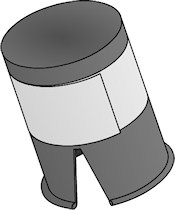|
BUFF method
The BUFF method (Brothers United for Future Foreskins) was the first modern-day non-surgical method of foreskin restoration to gain widespread acceptance. It consists solely of cross-taping (which it calls "tape strap") followed by ring-taping ("tape ring"). It has been practiced successfully since 1982, although as it does not use (and, indeed, advises against using) tension, it is one of the slowest restoration methods.
T-taping
Many methods make use of T-taping in one form or another, including the MTC method, but in the original form developed in the early 1990s, two long strips of three or four inch wide cloth tape are folded lengthwise and stuck together, producing a single T-tape with a very long tab. This T-tape is wrapped around the penis either over the scar line or the point of equilibrium (P.O.E.) of the remaining inner foreskin and the outer foreskin combined with the shaft skin. The tab is then gathered and clipped or tied to an elastic belt. In terms of speed, it is a great improvement over the BUFF method, but using a single T-tape, it is difficult to control the foreskin's growth and shape.
Canister method
In this method, a 35mm film canister is wrapped in tape, sticky side out. The canister is then squeezed over the glans penis (a cut-out may need to be made to accommodate the frenulum if yours is intact) and the remaining foreskin rolled up and onto the tape. More tape is then wrapped around the foreskin to secure it to the canister. The canister can then be either attached to an elastic belt or weight, or it may be packed with gauze, which provides tension by pushing against the glans penis.
O-ring method
This method is only possible if you were circumcised loosely or have already restored a considerable amount of foreskin using some other method. It is essentially a form of tape-less ring-taping. The foreskin is pulled over the glans penis and held in place using rubber O-rings. It has the same shortcomings as ordinary ring-taping plus it can be difficult to find O-rings tight enough to retain the foreskin, but not so tight as to restrict blood flow.
Better Than O-Rings method
This is an adaptation of the O-ring method that, instead of using O-rings, uses short lengths of foam rubber tubing, such as the kind used for bicycle handlebar covers. As it can be cut to any length, only one tube needs to be worn -- unlike O-rings, where you may need to apply several.
Manual Restoration
Manual restoration uses no tape or devices of any sort. There are various methods , but all consist of gripping the foreskin and stretching it by hand. I personally am very skeptical of manual restoration's effectiveness, but some report success using the technique. , but all consist of gripping the foreskin and stretching it by hand. I personally am very skeptical of manual restoration's effectiveness, but some report success using the technique.
|
BUFF tape strap
|

